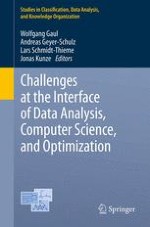2012 | OriginalPaper | Buchkapitel
Identifying Artificial Actors in E-Dating: A Probabilistic Segmentation Based on Interactional Pattern Analysis
verfasst von : Andreas Schmitz, Olga Yanenko, Marcel Hebing
Erschienen in: Challenges at the Interface of Data Analysis, Computer Science, and Optimization
Verlag: Springer Berlin Heidelberg
Aktivieren Sie unsere intelligente Suche, um passende Fachinhalte oder Patente zu finden.
Wählen Sie Textabschnitte aus um mit Künstlicher Intelligenz passenden Patente zu finden. powered by
Markieren Sie Textabschnitte, um KI-gestützt weitere passende Inhalte zu finden. powered by
